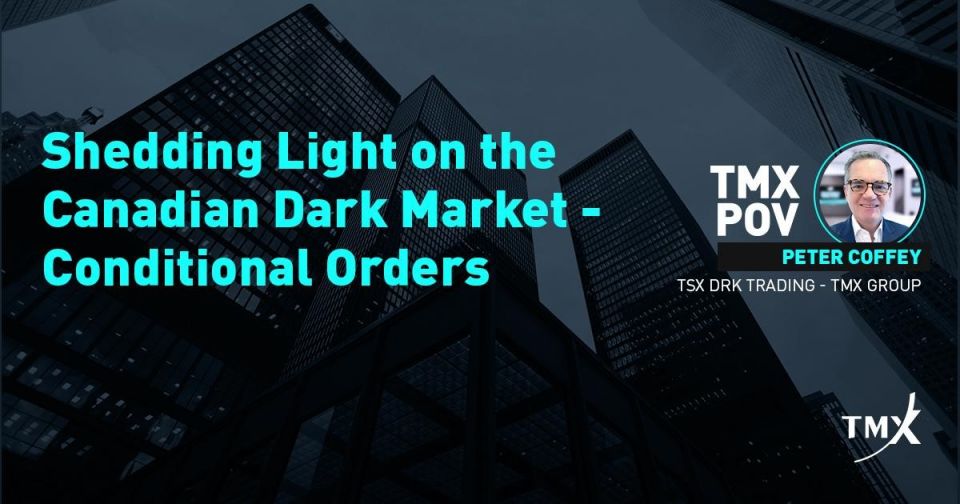TMX POV - Shedding Light on the Dark Canadian Market – Conditional Orders

Conditional orders in dark venues and alternative trading systems (ATSs) have been in the U.S. equities markets for several years and continue to grow in market share. They are now becoming more common in Canada and it wouldn't be surprising to see more conditional order books launched from Canadian exchanges and marketplaces this year.
What is a Conditional Order?
Conditional orders enable traders to search for liquidity in multiple dark venues by representing their orders ‘conditionally', without committing an order to any single market. When the contra side of the order meets specified criteria and is matched against the conditional order, these orders must ‘firm up' in order to execute, which confirms their intention to trade and cancels similar orders in other venues. In an increasingly fragmented market, conditional orders allow institutions to be represented anonymously in several markets without the risk of overfilling or double execution. The general structure of conditional orders is similar across the marketplaces, with a variety of differentiated offerings, including minimum size requirements, timing, interaction, priority, liquidity and behaviour enforcement. It is important to understand these differences, particularly with the complexity in the U.S. markets when utilizing these venues and accessing them as an essential larger-order liquidity source.
Brief History of Conditional Orders
Conditional orders were originally developed and offered in the U.S. by institutional block trading venues during the mid to late 2000s, including BIDS, Liquidnet and Posit, in order for institutional traders to simultaneously access these sources of large-order liquidity (block orders in the Canadian equities markets are typically defined as greater than 10,000 shares or $100,000 in value). The purpose was to manually access and trade hidden liquidity in the multiple block venues through an execution management system (EMS) by receiving a ‘pop-up' window to confirm and negotiate your order while cancelling in other markets and dealers. Average execution size in these venues were generally well above the block definition and in the +30,000 share range, as well as providing price improvement typically at the midpoint of the National Best Bid and Offer (NBBO).
With the proliferation of ATSs and dark venues in the U.S. over the past several years and the resulting fragmentation of the market, conditional orders became more popular with other marketplaces, particularly broker-sponsored venues, and a necessary tool for institutional traders. Today, over 20 U.S. ATSs offer conditional orders and their use has been widely adopted by the institutional and retail trading communities as a method to access hidden liquidity and can represent over 20% of their volume. The U.S. block venues still dominate in the space and maintain large average size executions, but overall, with the introduction of new venues, there has also been a decrease in average sizes of conditional orders across the ATSs. Additionally, the use of conditional orders is now predominantly driven by algorithmic trading with sub-second firm-ups, rather than the former, more manual EMS approach.
Benefits and Concerns of Conditionals
Conditional orders have numerous benefits, namely anonymously accessing large hidden and natural liquidity, and have become almost a must-have when trading equities markets, such as in the U.S. The majority of conditional books have higher than the average size 10,000 share block-sized trades, these venues are particularly useful for institutional clients to source larger and natural liquidity. And as block trades decline in Canada and the U.S. (according to TSX data *, Canadian block volume is approximately only 6% YTD 2021 in reported attributed markets), due to algorithmic trading, volatility and declined use of capital in the upstairs markets, institutional clients should welcome the opportunity to access block liquidity. Another advantage of conditionals over other dark order types is the ability to be represented in multiple places at the same time, reducing the previous matching issues of ‘two ships passing in the night' or ‘putting all your eggs in one basket'. You can search for deep pools of liquidity without committing your order. Finally, there is always the institutional concern of information leakage and market impact on large orders, which can also be reduced when trading in dark markets with a minimum quantity requirement. Minimum size and midpoint requirements in conditional orders make it much more difficult for others to determine if there is a large natural order in the pool and attempt to move the market away from its levels.
Are there any pitfalls to conditional orders? Perhaps. Conditional orders came out of the necessity to access multiple pools of dark liquidity in the fragmented U.S. market. With over 20 conditional books in the U.S. market, they are not all created equally and there can be a false sense of security that an institutional order is being represented the same across all venues. Many of the U.S. conditional books are broker-sponsored and can represent internalized flow and payment-for-order flow, which is becoming a familiar topic and concern these days. There can be signalling, fading and toxicity in some U.S. conditional books that institutions should be careful of. Conditional books are also ‘self-policing', meaning that the venues (not the regulators) are responsible for most rules enforcement and turning off those interested in misusing the system.
Navigating the Conditional Markets
As with any market or venue, clients and dealers clearly need to understand the functionality, rules, liquidity profile and market integrity of a conditional pool. This can be accessed through the exchange or venue and through various independent research and market structure firms. Since conditional books are now generally accessed through algorithmic trading, it's also important to understand how the algorithms ("algos") work and which pools they participate in -- this can be determined through a broker-dealer or algo provider. Algo providers can optimize certain pools of liquidity and even avoid toxic markets. This becomes particularly important for Canadian interlisted securities that are being routed to the U.S. dark and conditional books, which may need to be avoided in order to ensure that the order is represented fairly and with best-execution as the priority.
What's happening in Canada?
Conditional orders for broker-dealer flow was first introduced to Canada a few years ago (previously available only through buyside block venues) and still represents less than1%* of the overall market. There are three conditional books available on Canadian markets today, volumes are growing and order sizes are encouraging (average over 10,000 shares). It's still early days in Canada and even the venues that currently offer sellside conditional orders represent only a small percentage of their volume. Given Canada's Order Protection and Fair Access rules, it's highly unlikely that we will see the expansion of conditional orders and fragmentation that we are witnessing south of the border, which is a good thing. There will be more conditional orders available in Canada that investors and dealers should be aware of, including Toronto Stock Exchange's dark book TSX DRK, launching later this year, which will be introduced in an innovative, fair and principled approach. The focus will be based on why dark and conditional orders came to the market, which is anticipated to provide deep hidden liquidity and service large orders anonymously with price improvement and best execution. Conditional orders are here to stay and can be a real benefit to Canadian market structure when implemented well.
* Calculated based on Canadian consolidated data feeds internally gathered by TMX (excluding intentional crosses)
Copyright © 2021 TSX Inc. All rights reserved. Do not copy, distribute, sell or modify this document without TSX Inc.'s prior written consent. This information is provided for information purposes only. Neither TMX Group Limited nor any of its affiliated companies guarantees the completeness of the information contained in this article, and we are not responsible for any errors or omissions in or your use of, or reliance on, the information. The views, opinions and advice provided in the article are those of the individual authors.This article is not intended to provide legal, accounting, tax, investment, financial or other advice and should not be relied upon for such advice. The information provided is not an invitation to purchase securities listed on Toronto Stock Exchange and/or TSX Venture Exchange. TMX Group and its affiliated companies do not endorse or recommend any marketplace, exchange or securities referenced in this publication. TMX, the TMX design, The Future is Yours to See., Toronto Stock Exchange, TSX, TSX DRK, and Voir le futur. Réaliser l'avenir. are the trademarks of TSX


